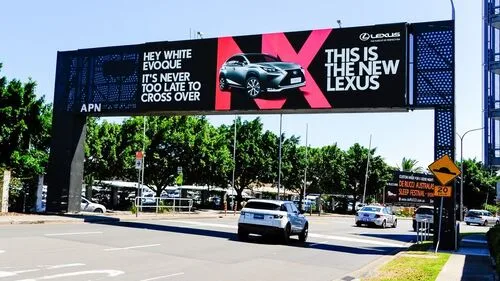Recently, there have been frequent incidents of outdoor advertising billboards falling and building facades falling, which have brought great safety hazards to society. At the same time, with the arrival of the rainy season, bad weather conditions have further increased the risk of billboards falling. As an important form of outdoor advertising signs, LED displays are located in busy areas with dense traffic and are often exposed to wind and sun, and their safety is of paramount importance. In order to prevent the occurrence of such accidents, outdoor LED displays must take strong measures in terms of structural design, installation methods, regular maintenance and maintenance before installation.
#Muenled
#outdoorLEDscreens
All posts tagged: led display
The hardest part of starting up is starting out

Methods to prevent outdoor LED advertising screens from falling off.

Large outdoor LED screens attract more viewers
With the continuous upgrading of market demand and the continuous iterative updating of new scenes in commercial space, large outdoor LED screens incorporating the most advanced sound and light stage technology in the future have attracted people’s attention. Among the many ways to build a differentiated experience, large screens can make people instantly detached from reality and feel happy and satisfied with a new sensory experience. Many companies are willing to spend a lot of money on this unique “landscape”, so what can this seemingly ordinary “LED electronic board” bring to brand drainage?
#Muenled
#outdoorLEDscreens

Introduction to Outdoor LED Display
Outdoor LED display, as the new favorite of the future outdoor display advertising media. The area is generally dozens of square meters to several hundred square meters or even larger, with high brightness and large viewing Angle. Can work in the sun, and has a certain wind, rain, waterproof function. Mainly used in outdoor advertising, stations, squares, shopping malls and so on. Outdoor LED advertising screen refers to its use environment is in the outdoor environment of the LED advertising screen, is the LED display system composed of LED components, generally in two-color, is the main form of color LED display
The outdoor LED advertising screen is composed of a lattice structure, the prime is a bright light point, the lattice structure is composed of “row” and “column”, the arrangement of the prime forms the pixels of the LED advertising screen, and the pixels form the physical structure and the group diagram of the LED advertising screen, which provides a good display structure framework for the LED advertising screen. Do you know what is the difference between outdoor LED display and indoor LED display?
#Muenled
#OutdoorLEDdisplay

What are the factors that affect the quality of full-color LED display screens?
The quality of full-color LED display screens is affected by multiple factors. In terms of LED chips, chip quality determines brightness, color, and lifespan, while packaging technology affects heat dissipation, moisture resistance, and service life. In the driving circuit, the performance of the driving chip is related to brightness consistency, and the rationality of circuit design affects stability and anti-interference ability. The grayscale level of the control system affects color transition, and the refresh rate determines the display effect of dynamic images. In terms of heat dissipation design, the heat dissipation method and structure affect the performance and stability of the display screen. In addition, the quality of raw materials such as PCB boards also plays an important role in the normal operation of display screens.
#Muenled
# full-colorLEDdisplay

Requirements for purchasing outdoor LED display screens
Choosing the best outdoor LED screen ensures high performance, durability, and cost-effectiveness. By focusing on key factors like pixel pitch, brightness, and weather resistance, you can make an informed decision that meets your specific needs.
#Muenled
#outdoorLEDdisplay

Choose the appropriate pixel spacing for outdoor LED signs
What Pixel Pitch Outdoor LED Sign is the best choice for your Outdoor LED Sign? Currently, the main model of Outdoor LED Display are: P4, P5, P6, P8, P10, P12, P16, how to make right choice to select the most fit Pixel pitch ?
#Muenled
#outdoorLEDsigns

The reason why proper heat dissipation is crucial for the performance of LED displays
Imagine relaxing on a hot summer day with a cold drink, enjoying the gentle breeze. Suddenly, the fan stops working. The cool air disappears, and you’re sweltering in heat in no time. This situation isn’t too different from what happens inside an LED display if it doesn’t dissipate heat efficiently. But why should you care? If you’re an LED display owner or enthusiast, the term “heat dissipation” is one matter you need to learn a lot about. Let’s dive into it!
#Muenled
#LEDdisplay

Reasons why outdoor LED screens can be used for business purposes
Are you looking for a sustainable and eco-friendly solution to promote your business? If so, then LED screens could be the answer. LED screens are an excellent way to promote your business and are also environmentally friendly, energy-efficient, and cost-effective. This article will discuss four reasons you should consider sustainable LED screens for your business.
#Muenled
#OutdoorLEDscreens

Fully utilize the technical skills of outdoor LED display screens
There is no way out better than outdoor led display to draw the attention of customers towards your brand. There are proven key tips to raise brand awareness with functional, affordable and effective outdoor displays. Say goodbye to traditional printed materials of the past and adopt crystal-clear picture, bright colors and vivid display and what’s the best part of all?
#Muenled
#outdoorLEDdisplay

Outdoor LED display screen for outdoor advertising
In this modern world, the advertising landscape is getting competitive day by day. Businesses are using different ways to reach their customers. LED display screen has emerged as one of the popular ways to promote all kinds of brands and businesses.
#Muenled
#OutdoorLEDdisplay
#outdooradvertising